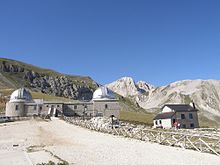Campo Imperatore Near-Earth Object Survey

Observatory of Campo Imperatore, Gran Sasso
|
|
| Survey type |
observatory, astronomical survey |
|---|---|
| Observatory code | 599 |
| Started | 2001 |
|
[]
|
|
The CINEOS program (Campo Imperatore Near-Earth Object Survey), started in 2001, is dedicated to the discovery and follow-up of near-Earth objects (NEOs), namely asteroids and comets which periodically approach or intersect the Earth's orbit. In particular CINEOS is addressed to the discovery of Atens and Interior-Earth Objects (IEOs) by extending survey coverage at small solar elongations, and to the discovery of the other kind of NEOs by observing with longer exposures (up to a limiting magnitude of 21) in the opposition region.
Between August 2001 and November 2004, CINEOS measured more than 61000 asteroid positions and discovered more than 1500 new objects, including several NEOs and one Centaur (planetoid). In June–September 2003, CINEOS was ranked fifth in the world for the number of discoveries (sixth place in the period June–August 2004) and has been the first Italian professional program to discover a NEO and an asteroid beyond the orbit of Jupiter.
The survey is carried out at the Campo Imperatore station of the Rome Observatory near the summit of the Gran Sasso Mountain, at about 2,150 meters of elevation. The station is located about 130 km north-east of Rome. Longitude and latitude are respectively 13.5581 deg East and 42.4442 North. The Observatory of Turin has been also involved in this project. Operated at the Schmidt telescope (60-90–183 cm) available at the station, the program uses between 10 and 14 nights per month, usually around the first and last quarter of the moon.
The science of CINEOS consists of two main observing activities:
To search for near-Earth objects (NEOs), concentrating activities at small solar elongations. The objective is to optimize a ground-based system towards the discoveries of:
Although the NEO discovery rate grew significantly from 2001 to 2005, knowledge of bodies with small semimajor axis remains largely incomplete (Atens) or totally incomplete (Inner-Earth Objects). Most search programs concentrate their efforts near the opposition region where it is difficult if not impossible to find these objects.
...
Wikipedia
